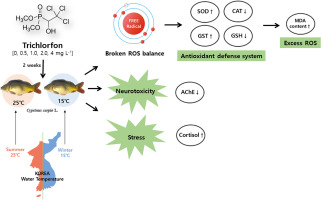当前位置:
X-MOL 学术
›
Comp. Biochem. Physiol. C Toxicol. Pharmacol.
›
论文详情
Our official English website, www.x-mol.net, welcomes your
feedback! (Note: you will need to create a separate account there.)
Effects of trichlorfon on oxidative stress, neurotoxicity, and cortisol levels in common carp, Cyprinus carpio L., at different temperatures.
Comparative Biochemistry and Physiology C: Toxicology & Pharmacology ( IF 3.9 ) Pub Date : 2019-12-26 , DOI: 10.1016/j.cbpc.2019.108698 Soo Ji Woo 1 , Joon Ki Chung 2
Comparative Biochemistry and Physiology C: Toxicology & Pharmacology ( IF 3.9 ) Pub Date : 2019-12-26 , DOI: 10.1016/j.cbpc.2019.108698 Soo Ji Woo 1 , Joon Ki Chung 2
Affiliation

|
Trichlorfon (TCF) is an organophosphate compound used extensively as an anti-parasitic in aquaculture. In this study, we investigated the effects of TCF on the antioxidant defense system, acetylcholinesterase (AChE) activity, and stress responses in various tissues of common carp (Cyprinus carpio L.). C.carpio L. were exposed to different concentrations of TCF (0, 0.5, 1.0, 2.0, and 4 mg L-1) at 25 and 15 °C for two weeks (measurements were taken after week 1 and 2). TCF exposure induced significant alterations in antioxidant responses in the gills and the liver. The activities of superoxide dismutase (SOD) and glutathione S-transferase (GST) increased considerably after TCF exposure, depending on water temperature, whereas catalase (CAT) and glutathione (GSH) levels decreased notably after one and two weeks. Remarkable antioxidant responses were observed in the gills, suggesting the gills were more sensitive to oxidative stress than the liver based on CAT, GST, and GSH levels. Notable increases in MDA levels were observed in the gills and the liver. AChE activity was significantly inhibited in the brain and muscles even at the lowest TCF concentration of 0.5 mg L-1, indicating neurotoxicity following TCF exposure. As a stress indicator, plasma cortisol was significantly elevated following exposure to TCF depending on water temperature, thereby enhancing stress. These results suggest that TCF exposure can induce considerable alterations in antioxidant responses, neurotoxicity, and stress reaction depending on water temperature. The assayed enzymes are potential biomarkers of organophosphate contamination.
中文翻译:

敌百虫对不同温度下鲤鱼氧化应激,神经毒性和皮质醇水平的影响。
敌百虫(TCF)是一种有机磷酸盐化合物,广泛用作水产养殖中的抗寄生虫药。在这项研究中,我们调查了TCF对鲤鱼(Cyprinus carpio L.)各种组织中抗氧化防御系统,乙酰胆碱酯酶(AChE)活性和应激反应的影响。鲤鱼在25和15°C下暴露于不同浓度的TCF(0、0.5、1.0、2.0和4 mg L-1)暴露两周(在第1周和第2周后进行测量)。TCF暴露会导致腮和肝脏的抗氧化反应发生重大变化。TCF暴露后,超氧化物歧化酶(SOD)和谷胱甘肽S-转移酶(GST)的活性显着增加,具体取决于水温,而过氧化氢酶(CAT)和谷胱甘肽(GSH)的水平在第1和第2周后显着下降。在中观察到显着的抗氧化反应,表明基于CAT,GST和GSH的水平,than对氧化应激的反应比肝脏更敏感。在the和肝脏中,MDA含量显着增加。即使在最低的TCF浓度为0.5 mg L-1时,AChE活性在大脑和肌肉中也被显着抑制,表明TCF暴露后具有神经毒性。作为压力指示剂,根据水温,在暴露于TCF后血浆皮质醇显着升高,从而增强了压力。这些结果表明,TCF暴露会根据水温引起抗氧化反应,神经毒性和应激反应的显着改变。测定的酶是有机磷酸酯污染的潜在生物标志物。根据CAT,GST和GSH的水平,表明ing对氧化应激的反应比肝脏更敏感。在the和肝脏中,MDA含量显着增加。即使在最低的TCF浓度为0.5 mg L-1的情况下,大脑和肌肉中的AChE活性也被显着抑制,表明TCF暴露后具有神经毒性。作为压力指示剂,根据水温,在暴露于TCF后血浆皮质醇显着升高,从而增强了压力。这些结果表明,TCF暴露会根据水温引起抗氧化反应,神经毒性和应激反应的显着改变。测定的酶是有机磷酸酯污染的潜在生物标志物。根据CAT,GST和GSH的水平,表明ing对氧化应激的反应比肝脏更敏感。在the和肝脏中,MDA含量显着增加。即使在最低的TCF浓度为0.5 mg L-1时,AChE活性在大脑和肌肉中也被显着抑制,表明TCF暴露后具有神经毒性。作为压力指示剂,根据水温,在暴露于TCF后血浆皮质醇显着升高,从而增强了压力。这些结果表明,TCF暴露会根据水温引起抗氧化反应,神经毒性和应激反应的显着改变。测定的酶是有机磷酸酯污染的潜在生物标志物。在the和肝脏中,MDA含量显着增加。即使在最低的TCF浓度为0.5 mg L-1的情况下,大脑和肌肉中的AChE活性也被显着抑制,表明TCF暴露后具有神经毒性。作为压力指示剂,根据水温,在暴露于TCF后血浆皮质醇显着升高,从而增强了压力。这些结果表明,TCF暴露会根据水温引起抗氧化反应,神经毒性和应激反应的显着改变。测定的酶是有机磷酸酯污染的潜在生物标志物。在the和肝脏中观察到MDA水平显着增加。即使在最低的TCF浓度为0.5 mg L-1的情况下,大脑和肌肉中的AChE活性也被显着抑制,表明TCF暴露后具有神经毒性。作为压力指示剂,根据水温,在暴露于TCF后血浆皮质醇显着升高,从而增强了压力。这些结果表明,TCF暴露会根据水温引起抗氧化反应,神经毒性和应激反应的显着改变。测定的酶是有机磷酸酯污染的潜在生物标志物。作为压力指示剂,根据水温,在暴露于TCF后血浆皮质醇显着升高,从而增强了压力。这些结果表明,TCF暴露会根据水温引起抗氧化反应,神经毒性和应激反应的显着改变。测定的酶是有机磷酸酯污染的潜在生物标志物。作为压力指示剂,根据水温,在暴露于TCF后血浆皮质醇显着升高,从而增强了压力。这些结果表明,TCF暴露会根据水温引起抗氧化反应,神经毒性和应激反应的显着改变。测定的酶是有机磷酸酯污染的潜在生物标志物。
更新日期:2019-12-27
中文翻译:

敌百虫对不同温度下鲤鱼氧化应激,神经毒性和皮质醇水平的影响。
敌百虫(TCF)是一种有机磷酸盐化合物,广泛用作水产养殖中的抗寄生虫药。在这项研究中,我们调查了TCF对鲤鱼(Cyprinus carpio L.)各种组织中抗氧化防御系统,乙酰胆碱酯酶(AChE)活性和应激反应的影响。鲤鱼在25和15°C下暴露于不同浓度的TCF(0、0.5、1.0、2.0和4 mg L-1)暴露两周(在第1周和第2周后进行测量)。TCF暴露会导致腮和肝脏的抗氧化反应发生重大变化。TCF暴露后,超氧化物歧化酶(SOD)和谷胱甘肽S-转移酶(GST)的活性显着增加,具体取决于水温,而过氧化氢酶(CAT)和谷胱甘肽(GSH)的水平在第1和第2周后显着下降。在中观察到显着的抗氧化反应,表明基于CAT,GST和GSH的水平,than对氧化应激的反应比肝脏更敏感。在the和肝脏中,MDA含量显着增加。即使在最低的TCF浓度为0.5 mg L-1时,AChE活性在大脑和肌肉中也被显着抑制,表明TCF暴露后具有神经毒性。作为压力指示剂,根据水温,在暴露于TCF后血浆皮质醇显着升高,从而增强了压力。这些结果表明,TCF暴露会根据水温引起抗氧化反应,神经毒性和应激反应的显着改变。测定的酶是有机磷酸酯污染的潜在生物标志物。根据CAT,GST和GSH的水平,表明ing对氧化应激的反应比肝脏更敏感。在the和肝脏中,MDA含量显着增加。即使在最低的TCF浓度为0.5 mg L-1的情况下,大脑和肌肉中的AChE活性也被显着抑制,表明TCF暴露后具有神经毒性。作为压力指示剂,根据水温,在暴露于TCF后血浆皮质醇显着升高,从而增强了压力。这些结果表明,TCF暴露会根据水温引起抗氧化反应,神经毒性和应激反应的显着改变。测定的酶是有机磷酸酯污染的潜在生物标志物。根据CAT,GST和GSH的水平,表明ing对氧化应激的反应比肝脏更敏感。在the和肝脏中,MDA含量显着增加。即使在最低的TCF浓度为0.5 mg L-1时,AChE活性在大脑和肌肉中也被显着抑制,表明TCF暴露后具有神经毒性。作为压力指示剂,根据水温,在暴露于TCF后血浆皮质醇显着升高,从而增强了压力。这些结果表明,TCF暴露会根据水温引起抗氧化反应,神经毒性和应激反应的显着改变。测定的酶是有机磷酸酯污染的潜在生物标志物。在the和肝脏中,MDA含量显着增加。即使在最低的TCF浓度为0.5 mg L-1的情况下,大脑和肌肉中的AChE活性也被显着抑制,表明TCF暴露后具有神经毒性。作为压力指示剂,根据水温,在暴露于TCF后血浆皮质醇显着升高,从而增强了压力。这些结果表明,TCF暴露会根据水温引起抗氧化反应,神经毒性和应激反应的显着改变。测定的酶是有机磷酸酯污染的潜在生物标志物。在the和肝脏中观察到MDA水平显着增加。即使在最低的TCF浓度为0.5 mg L-1的情况下,大脑和肌肉中的AChE活性也被显着抑制,表明TCF暴露后具有神经毒性。作为压力指示剂,根据水温,在暴露于TCF后血浆皮质醇显着升高,从而增强了压力。这些结果表明,TCF暴露会根据水温引起抗氧化反应,神经毒性和应激反应的显着改变。测定的酶是有机磷酸酯污染的潜在生物标志物。作为压力指示剂,根据水温,在暴露于TCF后血浆皮质醇显着升高,从而增强了压力。这些结果表明,TCF暴露会根据水温引起抗氧化反应,神经毒性和应激反应的显着改变。测定的酶是有机磷酸酯污染的潜在生物标志物。作为压力指示剂,根据水温,在暴露于TCF后血浆皮质醇显着升高,从而增强了压力。这些结果表明,TCF暴露会根据水温引起抗氧化反应,神经毒性和应激反应的显着改变。测定的酶是有机磷酸酯污染的潜在生物标志物。











































 京公网安备 11010802027423号
京公网安备 11010802027423号